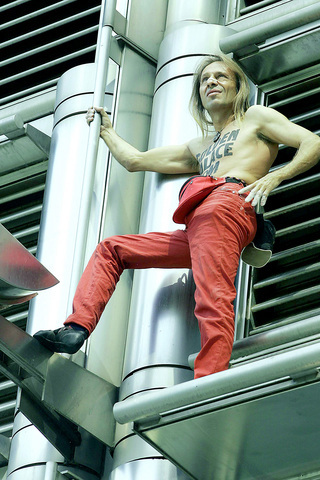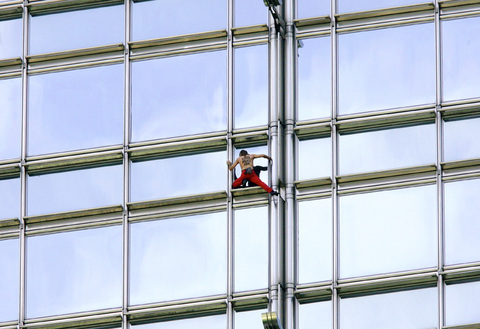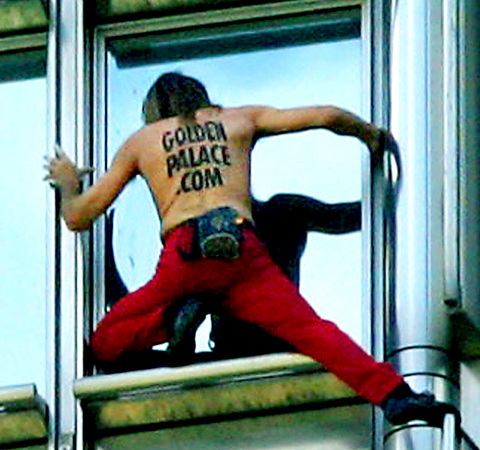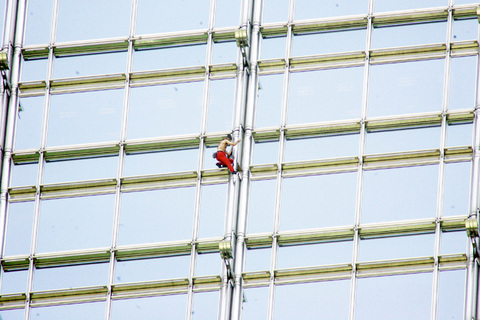Spiderman sits in a Hong Kong coffee bar and talks excitedly of his latest daredevil climb up another of the world's tallest skyscrapers using only his hands and feet -- no ropes, lines or harnesses.
"There is a feeling when you are that far up and you have your life in your fingertips, literally," enthuses stunt-man Alain Robert, known throughout the world as the "French Spiderman," throwing back his wild mane of hair.
"At that moment I am just a slip or a footfall away from death. There is no way to explain that feeling unless you are in that situation," he says.

PHOTOS: AGENCIES
Under a baking hot sun last week, Robert added Hong Kong's gleaming glass and steel Cheung Kong Centre to his list of conquests that includes New York' Empire State Building, Kuala Lumpur's Petronas Towers and Taipei 101, the world's tallest building at 508m.
As with most of his unauthorized climbs he was greeted at the summit by police officers, but escaped with a talking to rather than a few days in jail as has happened in some countries.
After climbing Tokyo's Shinjuku Metro Centre he was locked up for seven days -- the harshest punishment meted out so far.

"I slipped once or twice because there were wet patches I hadn't expected," a breathless, bare-chested Robert told reporters after the stunt in Hong, which took about 45 minutes and drew crowds of onlookers in the city's busy finance district.
A week of heavy rain in the city had almost forced the climber to cancel his assault on the 283m 63-storey Cheung Kong Centre and he admitted feeling more apprehensive than usual.
"I'm not sure why but I was more tense than usual," said the clearly relieved stuntman.

Robert, whose red leather trousers are as close as he gets to the red satin suit of the famed Marvel superhero, had kept the name of the target building a closely guarded secret for fear the police or security may be tipped off and prevent his ascent.
The diminutive climber -- he is just over five-feet tall (1.5m) -- is slender and has hands that look wrought from iron, strong and sure, the only piece of equipment that separates him from death.
"When you have been climbing as long as I have, this becomes the only way to climb," said Robert, speaking over a caramel latte on the eve of the climb, with a loud laugh.

Robert, now 42, began climbing at the age of 12 and within a couple of years was climbing solo in the ravines, cliffs and mountains of France.
He turned his passion to buildings in 1994 when he was asked to climb for a TV show. The producers quickly found there was nobody willing to let him up the side of their edifice, so he agreed to an illegal climb. That took place in Chicago and so began a love affair.
"I cannot do any normal job," he said with a huge grin, insisting he did it entirely for the money, not the glory. "You can live okay doing this -- I get sponsors who cover my costs and pay me a small fee to do it."
Unsurprisingly the Spiderman nickname came quickly and he even took to dressing as the comic book hero for some of his climbs.
No building is impossible to climb, Robert insists. Even modern glass and steel structures often have just deep enough grooves and fittings for him to find an adequate hand or foothold. Given the right weather conditions, he will climb a 110 storey mammoth like Chicagos Sears Tower in just over 90 minutes.
"I plan the climb so I know what to expect," he said. "It is rare I can't climb a building -- its only the law that will stop me, not the building."
He will make at least one visit to his intended climb before scaling it. The Hong Kong climb was planned a month ago on a previous visit. The Cheung Kong Centre was not built when he made his first climb here in 1996, when he climbed the Far East Finance Centre.
The climb will be a precursor to a series of five legal climbs on different buildings in each continent to help promote UNESCO projects.
"I will have to use ropes for those -- it is against my soul, but it is for UNESCO. How can I say no?" he said.

June 9 to June 15 A photo of two men riding trendy high-wheel Penny-Farthing bicycles past a Qing Dynasty gate aptly captures the essence of Taipei in 1897 — a newly colonized city on the cusp of great change. The Japanese began making significant modifications to the cityscape in 1899, tearing down Qing-era structures, widening boulevards and installing Western-style infrastructure and buildings. The photographer, Minosuke Imamura, only spent a year in Taiwan as a cartographer for the governor-general’s office, but he left behind a treasure trove of 130 images showing life at the onset of Japanese rule, spanning July 1897 to

One of the most important gripes that Taiwanese have about the Democratic Progressive Party (DPP) is that it has failed to deliver concretely on higher wages, housing prices and other bread-and-butter issues. The parallel complaint is that the DPP cares only about glamor issues, such as removing markers of Chinese Nationalist Party (KMT) colonialism by renaming them, or what the KMT codes as “de-Sinification.” Once again, as a critical election looms, the DPP is presenting evidence for that charge. The KMT was quick to jump on the recent proposal of the Ministry of the Interior (MOI) to rename roads that symbolize

On the evening of June 1, Control Yuan Secretary-General Lee Chun-yi (李俊俋) apologized and resigned in disgrace. His crime was instructing his driver to use a Control Yuan vehicle to transport his dog to a pet grooming salon. The Control Yuan is the government branch that investigates, audits and impeaches government officials for, among other things, misuse of government funds, so his misuse of a government vehicle was highly inappropriate. If this story were told to anyone living in the golden era of swaggering gangsters, flashy nouveau riche businessmen, and corrupt “black gold” politics of the 1980s and 1990s, they would have laughed.

Imagine being able to visit a museum and examine up close thousand-year-old pottery, revel alone in jewelry from centuries past, or peer inside a Versace bag. Now London’s V&A has launched a revolutionary new exhibition space, where visitors can choose from some 250,000 objects, order something they want to spend time looking at and have it delivered to a room for a private viewing. Most museums have thousands of precious and historic items hidden away in their stores, which the public never gets to see or enjoy. But the V&A Storehouse, which opened on May 31 in a converted warehouse, has come up